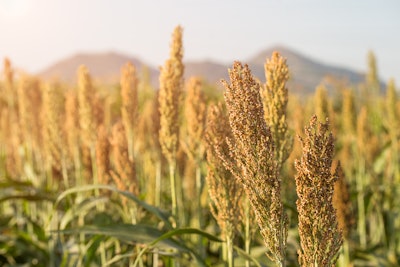
Farmers and feed manufacturers are beginning to embrace grain sorghum as a dynamic and beneficial solution to reduce agriculture's environmental impact while boosting productivity.
Sorghum is one of the top five grains produced globally and thrives in diverse growing regions, including North America, India and Australia. Its versatility, nutritional profile, and overall quality make it a good alternative feed option, positioned to help animal producers meet the growing demand for reduced reliance on traditional resources, which often come with higher environmental costs.
However, to fully leverage sorghum’s potential, the livestock and feed industries must address key challenges around digestibility, processing and infrastructure.
Sustainability and profitability in one
According to McKinsey & Company's Global Farmer Insights 2024, the adoption of sustainability-oriented practices among farmers is high, driven by increased yield and lower production costs. Sorghum farming is advantageous in both areas, especially when incorporated into cropping programs, which the report identifies as the leading sustainable farming practice worldwide. This practice not only optimizes land use, but also improves soil health, leading to increased yields.
Sorghum can precede or follow various other crops in crop rotation. Crops planted after sorghum show an average yield increase of 8%, according to the Sorghum United Foundation.
Another sustainability benefit of sorghum is its considerable drought tolerance and ability to thrive with less water. Its roots can extract tightly held water from the soil in areas with low rainfall, allowing it to produce reasonable yields. Sorghum's extensive root system also improves water infiltration, reduces erosion and fosters nutrient cycling.
In the U.S., sorghum yields range from about 90 to 150 bushels per acre without irrigation and from 130 to 220 bushels per acre with irrigation. While these amounts are lower than traditional crop yields, the reduced input costs for seed and water can lead to financial gains for many farmers. According to Nebraska Sorghum, sorghum's water consumption is about 250 units per bushel, which is approximately one-third of that required by crops like corn and rice that depend heavily on irrigation.
Sorghum can also help lower input costs for chemical treatments by breaking pest and disease cycles in the soil. This helps reduce greenhouse gas (GHG) emissions associated with fertilizer and pesticide production and application.
Nutritional strengths and challenges
Sorghum's nutritional profile is high in energy, balanced with protein, fiber, vitamins, and minerals needed to support healthy animal growth.
As an alternative feed ingredient, sorghum can offer efficient feed conversion rates in livestock and ruminants — and better resource utilization for a lower environmental impact. But sorghum’s biggest drawback compared to corn is its lower digestibility, particularly for swine and poultry.
The grain’s dense protein matrix can reduce nutrient availability, which could ultimately diminish feed efficiency and animal performance. Also, the presence of anti-nutritional compounds, such as tannins and polyphenols, can interfere with enzyme activity and mineral absorption.
Research from The University of Sydney shows that sorghum’s energy utilization can be significantly lower than corn, particularly when it is not properly processed. In broilers, poor starch digestibility has been linked to slower growth and reduced feed conversion rates.
Feeding sorghum successfully often requires intensive processing — like grinding, pelleting and thermal treatments — to improve starch availability. While pelleting improves digestibility, it adds costs. These processing demands may deter feed mills from incorporating higher levels of sorghum, especially when grains like corn are readily available.
Investment in research is taking place worldwide to address sorghum’s digestibility challenges. For example, a study by Texas A&M University found that the male sterile sorghum variety may promote digestibility in cows and higher milk production for dairy producers. This variety does not produce grain and remains green so it can maintain fiber digestibility longer than traditional sorghum.
In feeding trials, the researchers gradually replaced corn silage in dairy rations with male sterile sorghum, finding that a 25% replacement yielded the best milk production results.
One challenge is that male sterile sorghum is 70%-80% moisture content at harvest and requires careful moisture management. For dairy producers with limited water resources, it may still provide an effective alternative to traditional forages.
Consistent quality for global feed markets
The environmental benefits of sorghum are numerous, and the latest harvest quality data reveals U.S. sorghum is consistently high quality, as well. For the sixth consecutive year, U.S. sorghum, on average, graded above the requirements for U.S. No. 1 certification, according to the 2024/25 Sorghum Quality Report.
The U.S. Grains Council’s (USGC) annual sorghum harvest quality report, funded by the USDA's Foreign Agricultural Service and the United Sorghum Checkoff Program, offers critical information for international customers and end-users. The 2024/25 report analyzed 95 samples from 15 elevators in key sorghum-exporting regions, The samples, collected by the Amarillo Grain Exchange and analyzed at Kansas State University's Grain Science Department, represent nearly 100% of U.S. sorghum exports.
The analysis evaluates grain factors like grade, test weight, broken kernels, foreign material, heat damage, and tannins, which can affect the nutritional and functional properties of sorghum-containing feed rations.
Highlights from the report include a total sorghum damage rate of 0.3% on average, zero heat damage observed in the samples, and an absence of tannins for the sixth year. It also reported increased starch and oil content compared to the previous year's crop.
As agricultural challenges intensify worldwide, resilient crop alternatives that can increase productivity with fewer resources will be crucial. Sorghum meets this need, plus it delivers high harvest quality for feed markets.












